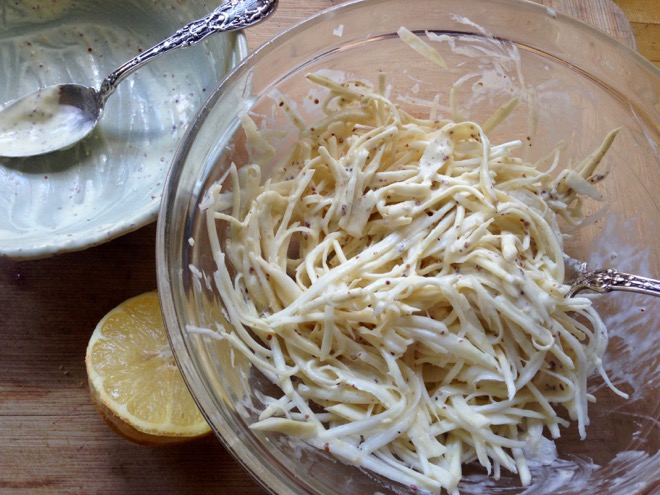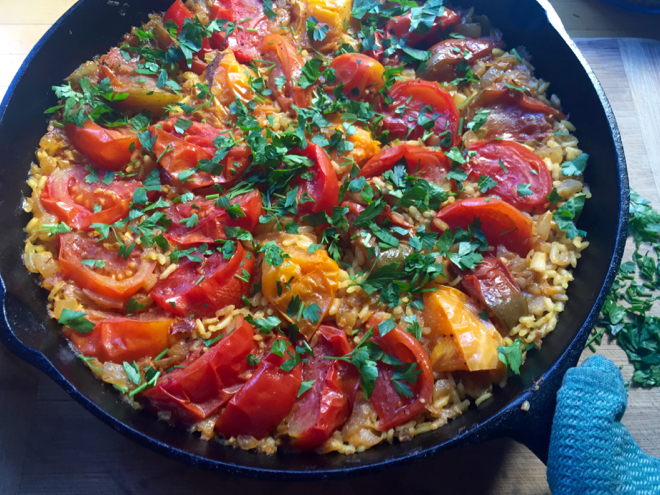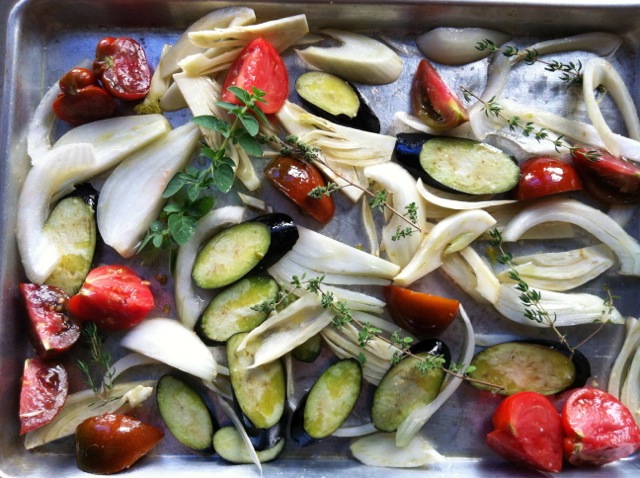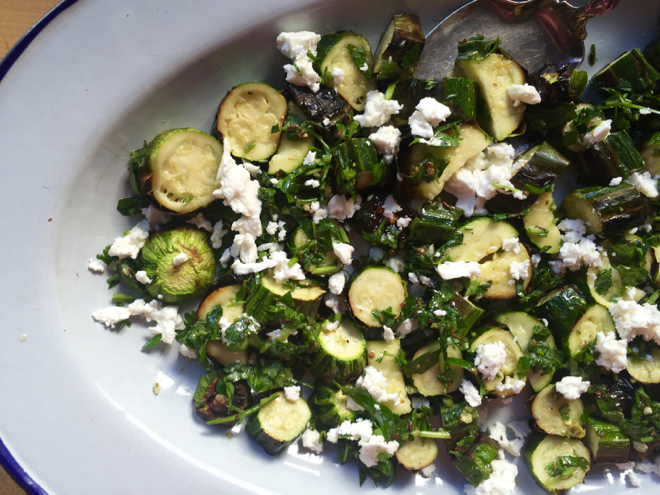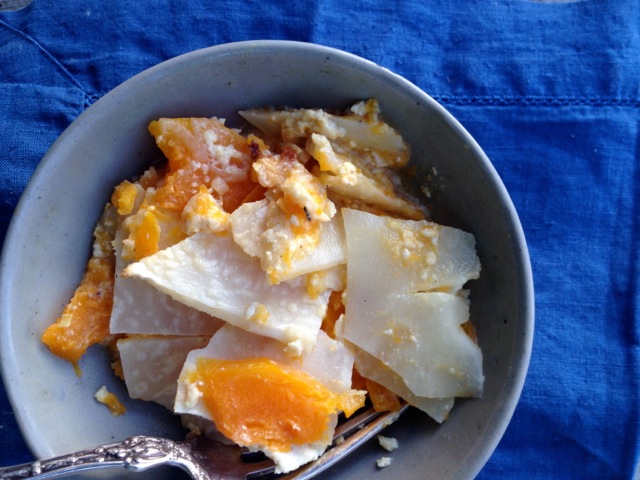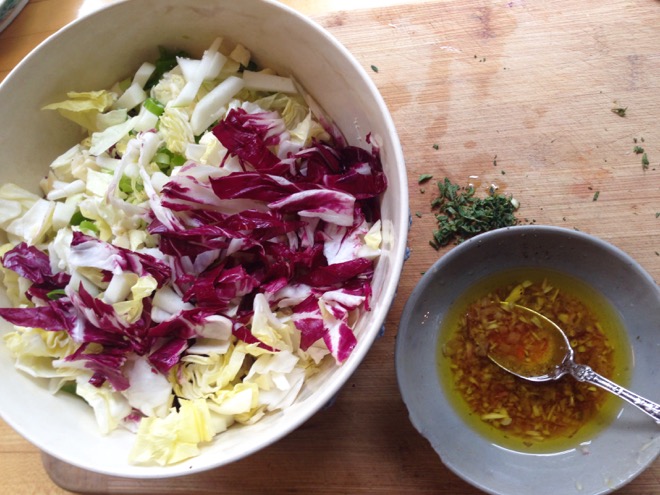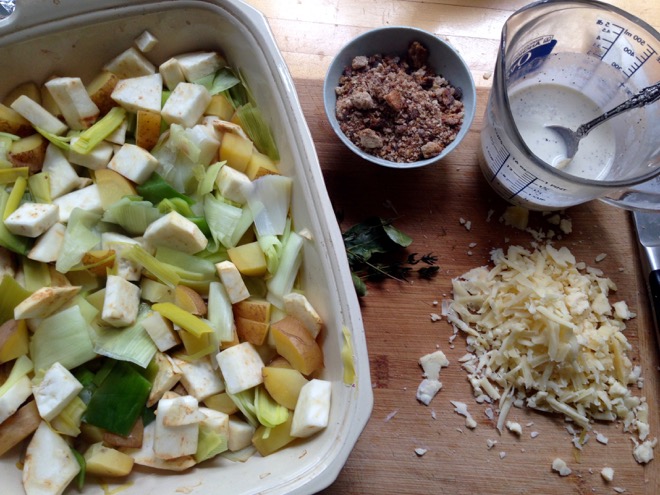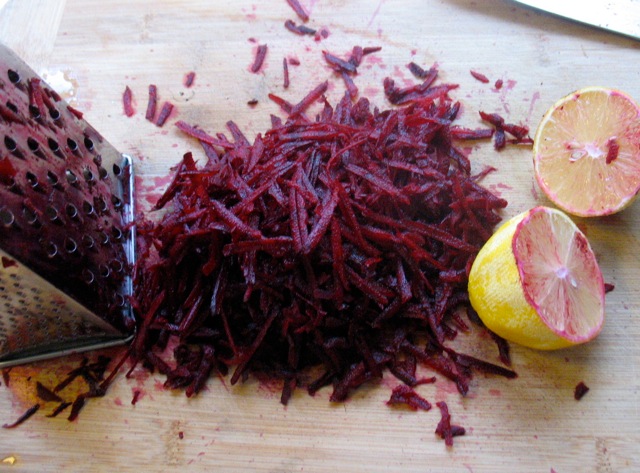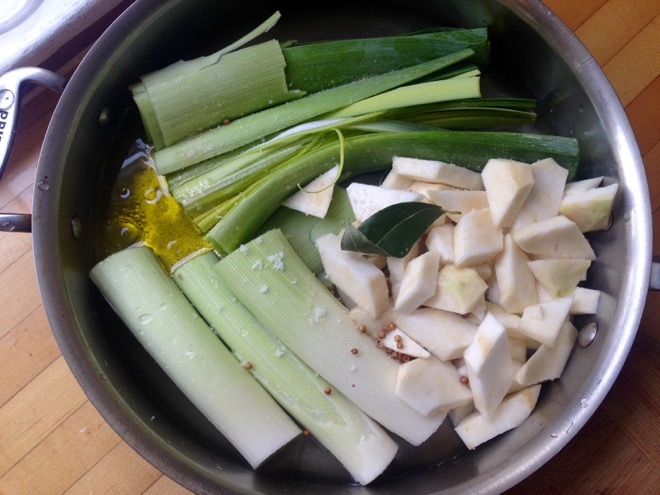It’s perfect cooking weather–not too hot, not too cold and the best of late summer produce and the beginning of fall. Enjoy!
Kohlrabi, Potatoes, Butter and Herbs
Simple Italian-style Chicken with Sweet Peppers and Tomatoes
Pasta with Eggplant, Tomatoes and Parsley
Beets with a Little Vinegar
Punjabi Style Potatoes and Tomatoes
Scalloped Celery Root and Potatoes
Celery Root Remoulade
Kohlrabi, Potatoes, Butter and Herbs
This is simple and delicious and you can omit the potatoes and just use kohlrabi if you’d like. It’s good to make with kohlrabi that are a little more fibrous as they get meltingly tender with this preparation.
Serves 4
1 large kohlrabi, peeled, quartered and sliced about 1/4-inch thick
4 medium firm fleshed potatoes (Yukon gold, red etc.) scrubbed and cut into 1/4-inch rounds
2 tablespoons butter
Salt
Black pepper
2 small sprigs fresh thyme or 1 teaspoon dried thyme leaves
2 tablespoons chopped chives or parsley
Bring about 2 inches of water to a boil in a large skillet. Add 1/2 teaspoon salt and add the sliced kohlrabi and potatoes. Cover and parboil for 4 minutes. Drain and set vegetables aside for a moment. Add a little butter to the dried and still hot pan and swirl it around. Then spread the kohlrabi slices evenly over the bottom of the pan. Sprinkle with a little salt and a grind or two of pepper. Dot with half the remaining butter and sprinkle over half the thyme leaves. Cover with potato slices and repeat with the remaining butter and thyme and a little more salt and pepper. Cover and return to the stove and cook gently, over low heat for 25 minutes until very tender and fragrant. You can turn the heat up at the end for a couple of minutes to brown the bottom layer if you’d like. Top with fresh chives or parsley and serve hot or warm.
Simple Italian-style Chicken with Sweet Peppers and Tomatoes
This is a straightforward preparation for a delicious late summer meal. Serve with a big green salad or some corn on the cob or just good, crusty bread and you’re set.
Serves 4
3-4 sweet peppers
2 tablespoons olive oil
2 garlic cloves, minced
1 chicken, cut into 10 pieces
¾ cup dry white wine
1- 1 ½ lbs tomatoes, diced
1/3 cup halved, pitted, cured black olives (optional)
Salt and freshly ground pepper
Chopped fresh parsley
Preheat the broiler. Roast the peppers, turning until all sides are blackened and blistered. Remove from oven and put in a bowl, covered by a plate to steam. When cool enough to handle, peel and seed and cut into strips.
Heat the oil in large, deep skillet. Add the chicken pieces, working in batches if you need to, and cook, turning to brown all sides. Return all the chicken to the pan (if you had to work in batches) and season generously with salt and pepper, add the garlic and the wine and cook until most of the wine has evaporated. Stir in the tomatoes and peppers and simmer, loosely covered for about 15 minutes, stirring occasionally. Add the olives, if using, and cook another 5 or so minutes until the chicken is tender and cooked through. If the sauce is too thin for your taste (as it sometimes is for mine) remove the chicken pieces and keep covered on a plate and reduce the sauce on high heat for a few minutes and then return the chicken to the pan. Serve with some chopped fresh parsley if you have some.
Pasta with Eggplant, Tomatoes and Parsley
This is a quick, hearty pasta dish. I seem to be incorrigibly drawn to Italian preparations in late summer. They’re so quick and easy and satisfying.
Serves 4
Olive oil
1 medium globe eggplant or several smaller ones, cut into ½ -inch dice (no need to peel, salt or soak)
2 -3 medium tomatoes, diced (depending on how saucy/tomato-y you want it)
2 cloves garlic, minced
1-2 tablespoons capers, rinsed and roughly chopped (optional)
2-3 tablespoons chopped parsley (or basil or a combination)
½ cup grated Parmesan or other hard cheese
3/4 lb fusilli, penne or other stout pasta
1/4 cup pasta cooking water, reserved before draining
Sauté the eggplant in a heavy skillet with 2 tablespoons of olive oil over high, then medium-high heat stirring frequently. When the eggplant is soft, add the tomatoes, capers, if using, and the garlic and several generous pinches of salt. Cook on high heat until the tomatoes break down just a bit and some of their liquid evaporates so you have a nice thick, chunky sauce—about 10 minutes. Add the parsley and/or basil.
Meanwhile cook the pasta in plenty of salted, boiling water until al dente. Right before you drain the pasta scoop out about ½ cup of pasta cooking water. Drain the pasta, toss with the sauce, add the reserved cooking water to loosen it up a bit and serve immediately with the cheese.
Beets with a Little Vinegar
Earthy, sweet beets love acidity. There is practically no simpler preparation than this and if the beets are good, this will be delicious.
5 small-ish beets, trimmed and scrubbed
1 tablespoon plus 1 teaspoon cider vinegar or vinegar of your choice (more or less, to taste)
Salt
1 tablespoon good, mild olive oil
Put the beets in a saucepan and cover generously with water. Cover and bring to a boil. Turn down to a simmer and cook for 25-40 minutes (depending on size and variety) until completely tender when pierced with the tip of a knife. Drain and when cool enough to handle, slip of skins. Cut into thin wedges and toss with the vinegar and sprinkle with salt. Let sit for at least five minutes to absorb vinegar. Then toss with olive oil. Taste and adjust seasoning Serve warm or at room temperature.
Then toss with olive oil. Taste and adjust seasoning Serve warm or at room temperature.
Punjabi Style Potatoes and Tomatoes
–adapted from World Vegetarian by Madhur Jaffrey
Richly flavored, hearty yet relatively light, this a wonderful combination of flavors and beyond a bit of chopping a cinch to make. It’s mild to medium spicy and you can adjust the level with more or less cayenne and by using/omitting the seeds of the fresh pepper. You can adapt the ratio of potatoes to tomatoes to suit your needs just be sure to keep enough liquid in the pan to keep it a bit saucy.
3 tablespoon peanut or sunflower oil (olive oil will be fine too)
1 medium onion, finely diced
1 tablespoon grated ginger
3 cloves garlic, minced and mashed with the side of chef’s knife a bit (don’t sweat it if you don’t have time for this)
About 4 medium tomatoes, diced (use less if you don’t have that many–you’ll just add a bit more water later)
1 jalapeño or serrano, finely chopped (include seeds unless you are very sensitive to spice)
1/3 teaspoon ground turmeric
1/8 teaspoon cayenne (see headnote)
1 teaspoon sea salt (more to taste)
1 – 1 1/2 lbs firm fleshed potatoes, scrubbed (peeled if you like) and cut into 1-inch dice
1/2 teaspoon garam masala
Fresh chopped cilantro, for serving (optional)
Heat the oil in a large heavy skillet. Saute the onions for 7-10 minutes until beginning to brown. Add the ginger and garlic and cook for another minute. Add the tomatoes, green chile and spices, salt and cook for 2-3 minutes on high. Add the potatoes and 1/2 cup water (more if you’re using fewer tomatoes) and bring to a lively simmer. Cover and turn down to low and cook for 20 minutes. Uncover and cook for a bit longer to reduce the sauce a bit. Taste and adjust seasoning. Serve hot or warm, topped with cilantro if you’d like.
Scalloped Celery Root and Potatoes
Celery root and potatoes combine for a delicious version of this classic, employing plenty of fresh parsley.
Serves 4-6
1 1/2 – 2 lbs Yukon gold potatoes, scrubbed and thinly sliced into rounds (blade on box grater works well)
1 lb celery root, trimmed and thinly sliced
1/2 onion, finely diced
1 1/2 cups grated sharp cheddar, emmental, gruyere, . . .
2 teaspoons ground cumin
1 1/2 teaspoons pimenton (smoked Spanish paprika–spicy or mild)
1/2 teaspoon chili flakes (optional)
2 teaspoons salt
3 tablespoons chopped fresh parsley
1/2 teaspoon black pepper
1/4 cup flour
About 3 1/2 cups liquid: all whole milk, part milk, part cream, part half & half, part veg or chicken stock, but be sure it’s at least 1/2 milk
Preheat oven to 400 degrees.
Put the potatoes and celery root in a large bowl. In a small bowl mix the flour, spices together. Sprinkle this over the potatoes and toss well. Add the onions and almost all of the cheese (reserving some for the top) and mix again.
Spread mixture in a 9 x 13 baking dish, pat down a bit with a spatula. Pour milk (or liquid combo) over potato mixture. The liquid should come about half way up the potatoes. Sprinkle the top with the remaining cheese, cover pan with foil and bake until potatoes are tender and easily pierced with a fork about 45 70 minutes. Uncover after about 30 minutes and finish baking until tender and run under the broiler for a minute or two to brown the top if you’d like. Cooking time will depend on how thinly you sliced your potatoes. Let sit for a few minutes before serving. Serve hot or warm.
And again, quantities are approximations so adjust depending on the number of people you’re feeding, etc.
Celery Root Remoulade
This is the classic French way to prepare celery root–and it is so very good. The celery root softens a bit but keeps that fresh, earthy flavor. A classic Celery Root Remoulade exclusively uses mayonnaise in the dressing, which is good but I suggest a combination of Greek yogurt and mayonnaise for a slightly tangier and fresher flavor here but by all means use just mayonnaise if that’s what you have.
Serves 6
Scant 2 lbs celery root, peeled
¼ cup mayonnaise
¼ cup whole milk regular or Greek yogurt
2 tablespoons lemon juice
2 teaspoons whole grain mustard
2 teaspoons Dijon-style mustard
A little white wine or cider vinegar
Salt and freshly ground pepper
You can either grate the celeriac in a food processor or if you can, use a mandolin to cut it into matchsticks. Toss the grated or cut celeriac with 1 teaspoon sea salt and most of the lemon juice. Let rest for at least 15 minutes and up to 30.
Whisk the remaining ingredients in a small bowl and pour over the veggies. Mix well and adjust seasoning.

